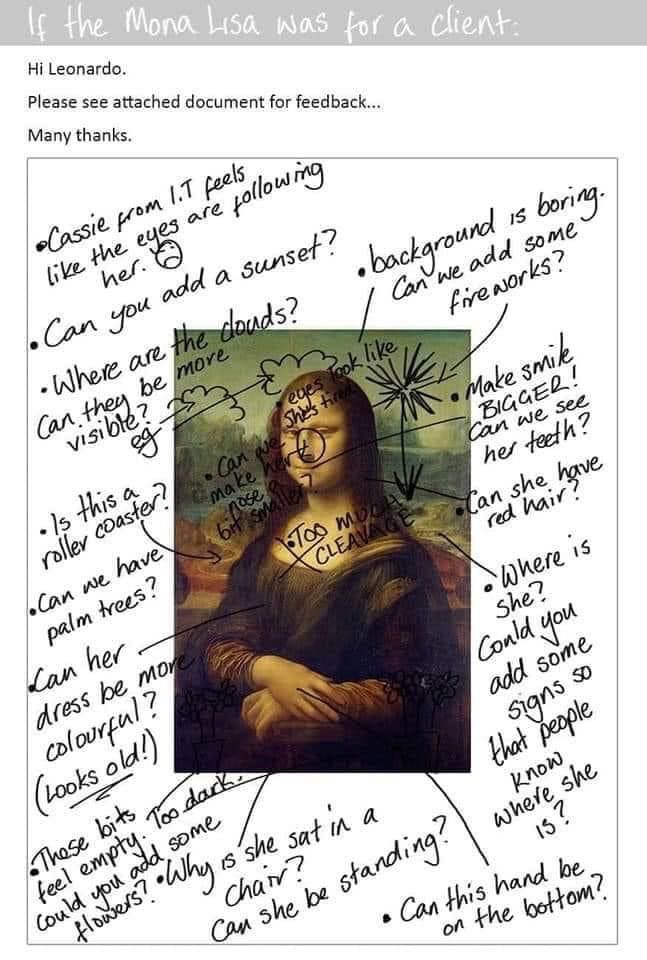When it comes to working with a branding and design team, never underestimate the importance of good feedback. By “good,” we don’t mean that we only want to hear praise. If the creative deliverables completely missed the mark from what was outlined in the creative brief, or if the fundamental needs of the project have changed, the client absolutely should speak up. Even bad news can be good if we can get the information we need to pivot quickly and get on track.
So, what is considered “good” feedback, you may wonder? It’s feedback that will help the client and the creative team understand how move the project toward the best possible result. And here are the four tips that can really make a difference.
#1 Keep it objective.
Individual opinions and preferences are fine. But when it comes to reviewing creative, it’s not about what we personally like or dislike. It should be about whether the evaluation is grounded in the strategy and direction we all agreed upon in the creative brief.
Another good tip in avoiding subjective feedback is to be as specific as you can. Statements like “make it pop” or “it feels off” can mean different things to different people. Instead, it’s best if you can articulate what is or isn’t working—and consider providing an example or a reference to illustrate what you mean. That said, you don’t have to necessarily “comp it up” unless it’s the best way for you to visually express your idea. If it is, then feel free to send it, as directional feedback rather than art direction. (We’ll expand on this idea in Tip #2.)

#2Start with the problem, not the solution.
While giving prescriptive feedback might seem like the quickest way to get there, it might not result in the best creative result. Problem-solving is what gets us up in the morning—so we welcome any opportunity to take up a challenge! Rather than simply telling us exactly what to do, start by telling us what’s working and what’s not—and then tell us why. That way, we can have a conversation about the problem, which could result in a totally different solution that’s even better!
If the problem is that you simply love both options (a great problem to have, obviously), let’s talk about what’s working on both options. It’s fairly common for clients to give feedback wanting to pull from two directions into one—we call it “Frankensteining”—but by having a conversation about it, we can work together to make sure that we’re choosing the right elements. Sometimes there are specific reasons to choose one element over another, from technical requirements to timing constraints. But if we work together to think it all through, Frankensteining can end up looking a lot better than it sounds.
#3 When in doubt, ask.
Great creative is a two-way street. As you might guess by now, we’re all about communication and collaboration with clients. But sometimes there are communication disconnects. Maybe the work was sent over via email without all rationale. Or perhaps a meeting got cut short and we didn’t have time to touch on a particular aspect of the work. But if you’re reviewing creative and something doesn’t seem to make sense to you, please ask. We guarantee that there’s a reason behind every creative decision. So, before you completely discount an approach, please reach out! It’s possible that we put it in there to solve a problem you may not even be aware of yet—like back-end requirements, platform limitations, or even timing constraints. So, just ask! Maybe we can change it. Maybe we can’t. But let’s explore the possibilities together.
#4 Consolidate all feedback FTW!
More often than not, creative gets reviewed by multiple people on a team—giving their perspectives, ideas, and answers to team questions. This is all great, but it works even better when all of those comments are consolidated and all questions or issues are resolved on the client side before that feedback is forwarded on to the agency. Even better, put it all in a single document! (This may not be possible in all instances, but it’s nice when it works out that way.)
Also, speed is a virtue. By gathering and sending all feedback in a timely manner, you’ll ensure that your creative team is focused—with the project’s goals and strategy fresh in their heads—so your project maintains momentum. Clear direction and quick alignment from the client side will save time, money, and sanity for us all.
And that’s it. Stick to these simple rules and you’ll find that projects run more efficiently and more effectively—and you’ll get better results. Plus, your agency will love you. And a little love goes a long way for future creative success.


